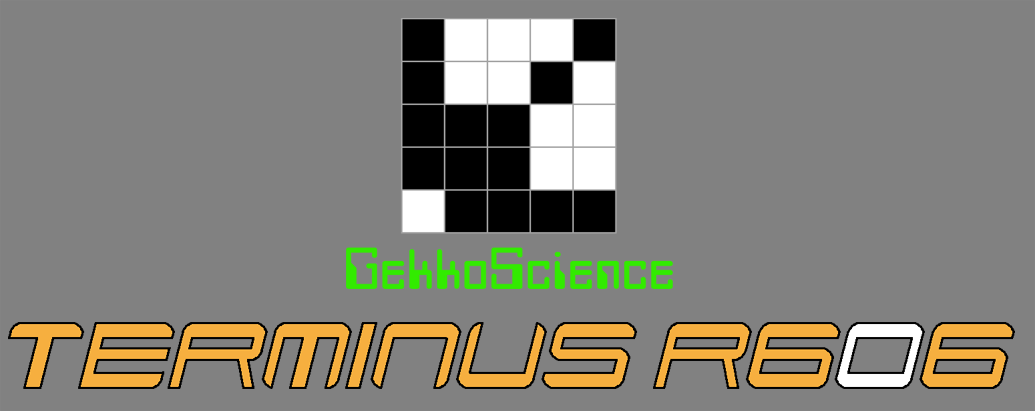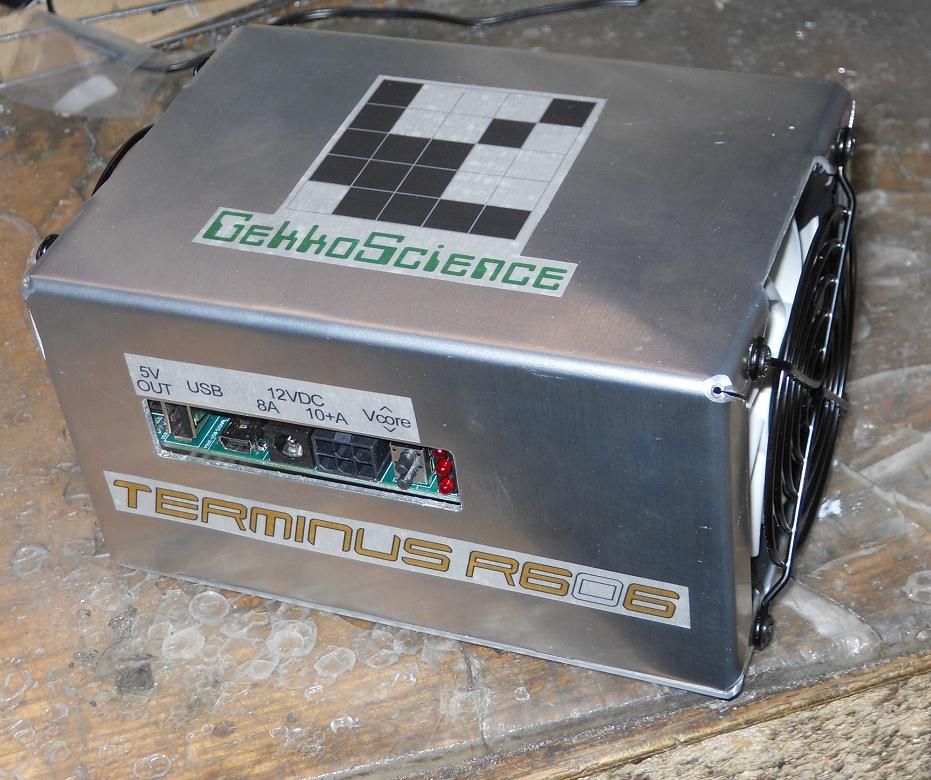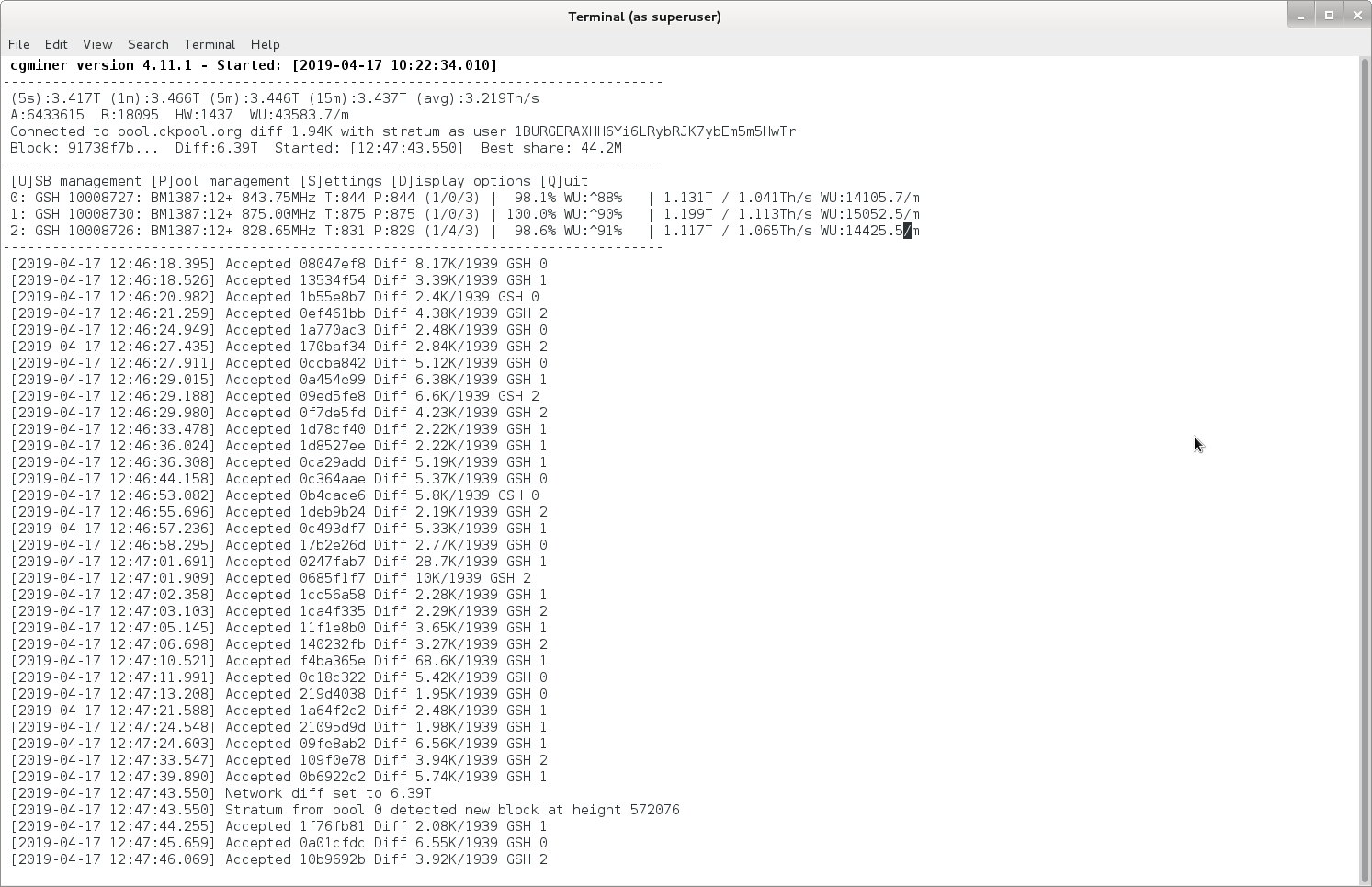 Show Posts Show Posts
|
|
Pages: [1] 2 3 »
|
Hello all. I hope you've been HALVING a good time mining lately! (yes, it wasn't funny; no, I won't apologize) Your old pals at GekkoScience are rolling out more stuff. Our new product for 2024, the first of many if everything works out, is a new stickminer. Of course it is; we always start with new stickminers. This fellow is called the Compac A1.  If you have figured out the nomenclature of our company and products, you know it's all an homage to Eureka Seven, in which the Amita Drive was attached to Renton's Compac Drive, expanding its abilities. In the same vein, we've added our own Amita Drive of sorts to the Compac A1 (get it?) in the form of built-in telemetry and software control. No longer will you need to reach for a tiny screwdriver to tweak the voltage; it'll be done in software via cgminer commands or the API. And you'll be able to watch the temperature! And the USB bus voltage! And even change how the blinky light blinks! It should be possible to adjust the voltage on the fly, making tuning easy. Should be pretty fun. There's also an optional 2-pin fan jack for snap-on fans without tying up another USB port. That's a new feature. Resellers will probably have add-on fan packages utilizing this. Please note that the fan jack is spec'd for fan loads only and CANNOT be used as an external 5V power input. You will burn things up by doing this. This stickminer is built around S19 chips for good efficency, approximately 30% better than the Compac F. Samples have marked Compac F stock speeds around 260GH from under 8 watts. Another benefit over the Compac F is low-end stability. It's built to handle high speeds, but unlike the F, it won't choke up at low speeds, so you don't have to overclock it on a juiced-up hub just to make it work. But you can if you want. I've clocked samples running over 550GH on stock Smart Hubs, with a bit beefed up cooling of course. The main regulator on this stick is built to handle high power, up around 20W without blinking. The LEDs will blink of course, but power won't. Power will be fine. And as always, these guys are Designed And Built In America.  *May not come in fancy retail packaging The Compac A1 will be shipping in May. We're working on our own website for limited direct sales, but in the meantime confirmed resellers include: AltairTech in USA Bitshopper.de in Germany The Solo Mining Co in England 101 Crypto in Australia MineFarmBuyEyeboot (under construction)BitcoinMerch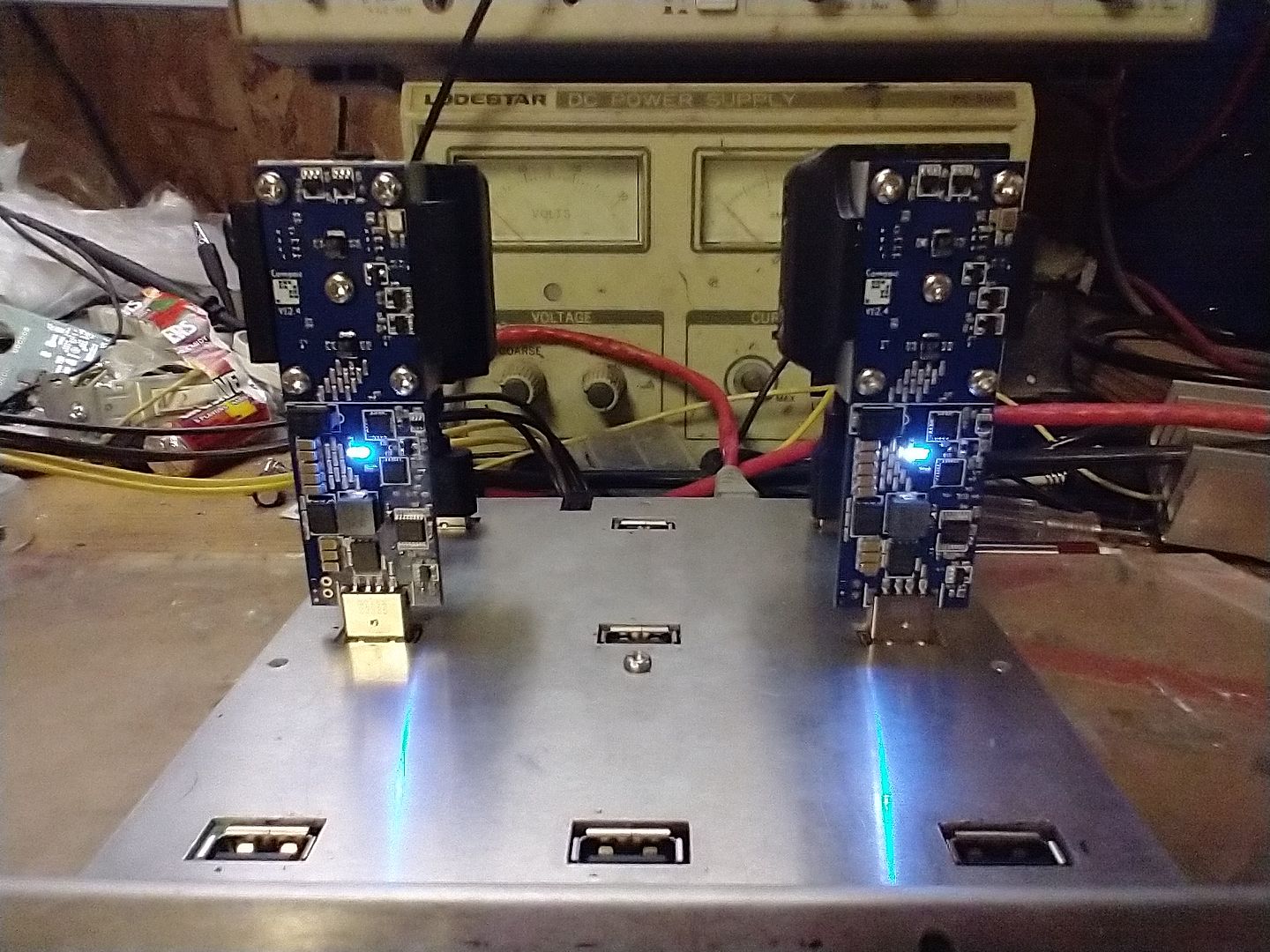 |
|
|
|
Hello, various fans and consumers of GekkoScience equipment As often happens around this time of year, we're pleased to announce the release of a new product! The Smart Hub 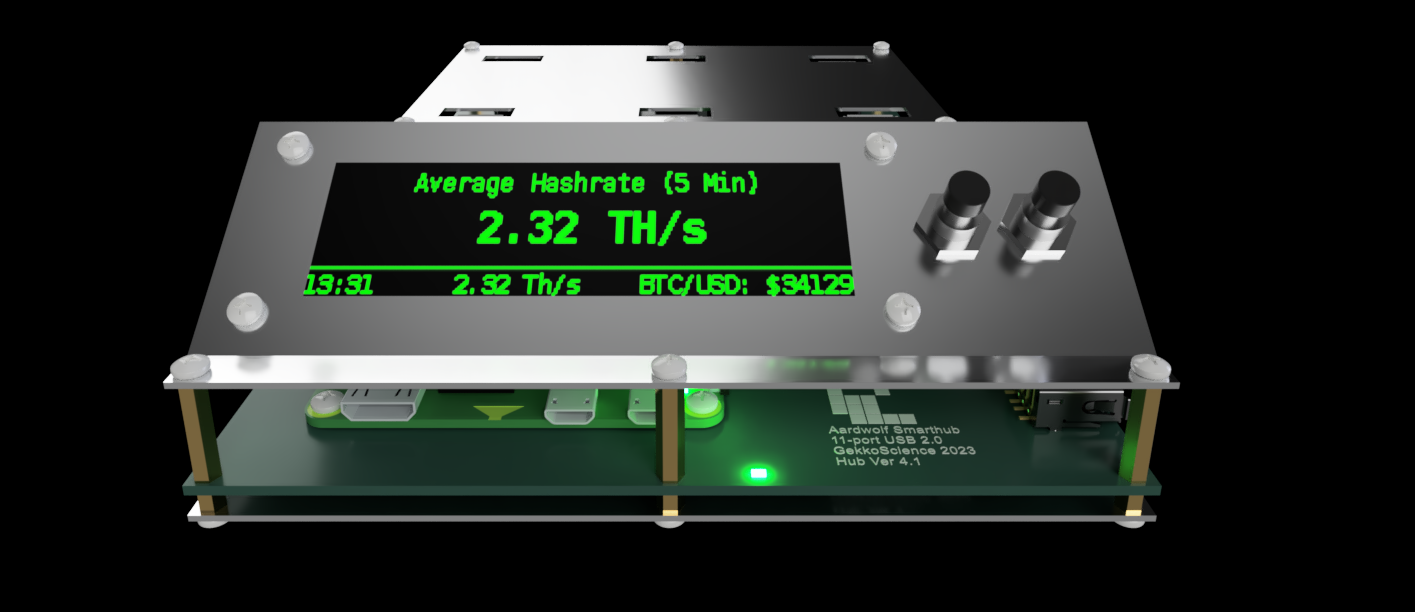  Basically we took the GekkoScience Base Hub and added a brain. We've got 9 powered ports on top, all with data - no dummy ports - and two lower-power side ports for extending to more regular hubs. All ports are protected with the same self-resetting 3.5A fuses we used on the upgraded Base Hub (any sold in the last year), and powered across two high-current main regulators for better power handling than any Base Hub so far. It's got a Raspberry Pi Zero W 2 controller built in, with integrated wifi and ethernet onboard. It's got a green-on-black OLED screen and software made for mining. We partnered up with the guy who originally designed what is now the Mars Lander for this one so it's at least slightly cooler-looking than our usual stuff, and has a pretty good software setup. On first boot or after a factory reset, this hub will boot as a wifi host and tell you its IP so you can connect to its convenient web interface. Over ethernet, it's immediately ready to configure. From there you can set up your local wifi and your pool configs and miner settings, which take effect upon reboot and persist until it's hardware-reset. The default mining mode cycles through stats (including individual miner hashrates) and keeps a running ticker of BTC/USD price as well as other useful data. This should reduce the learning curve for using our products, as it makes most things plug-and-play. No need to compile cgminer and SSH and command line - unless you want to, of course. It's still a linux computer, and useful for more than just mining. 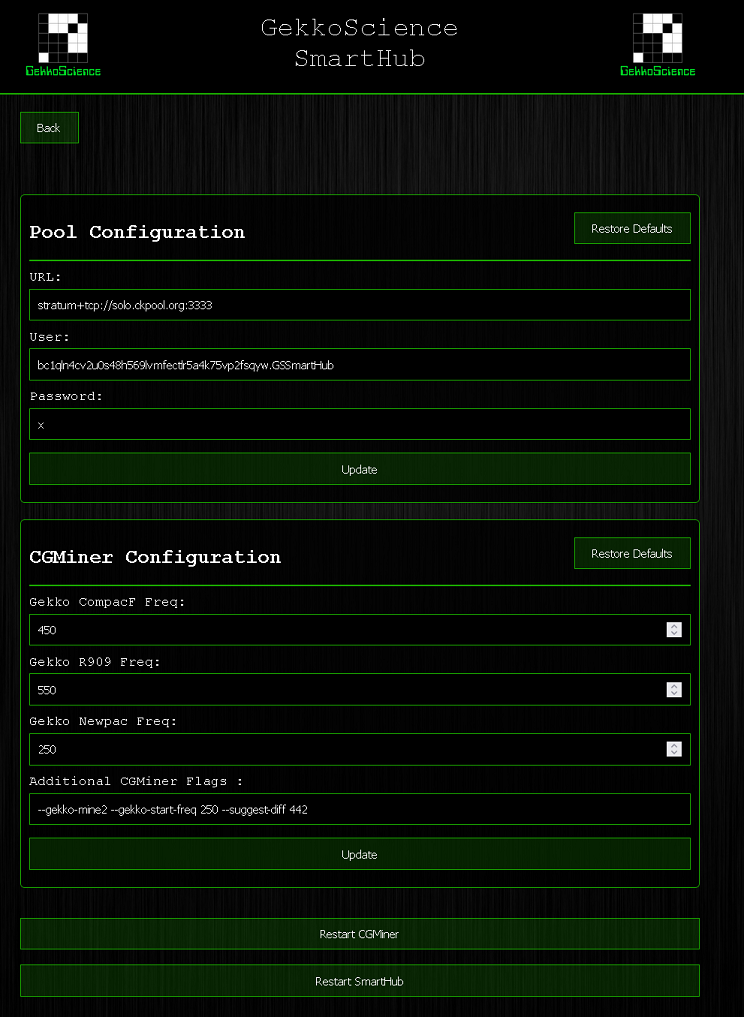 The vertical port spacing on the hub is sized for sticks with individual snap-on fans, so you can use all 9 ports for sticks. All 11 ports have data lines for connecting any USB miner or device, including another hub with more sticks, or a stack of R909 pods. 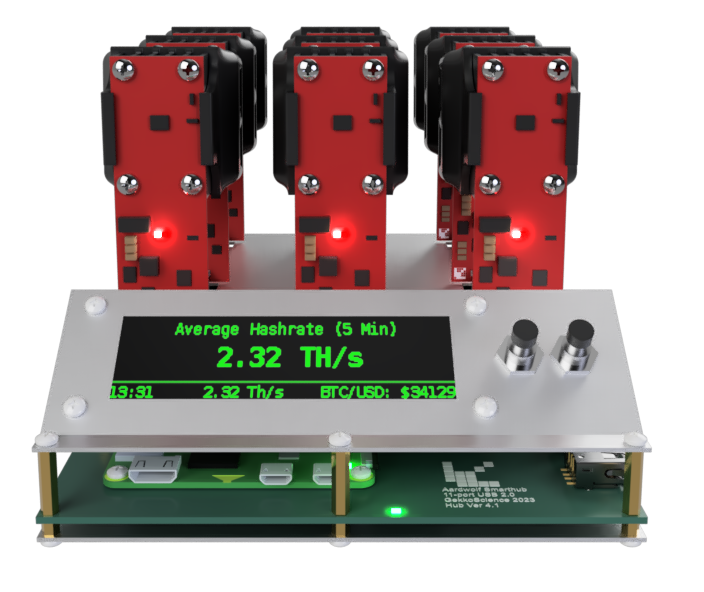 We'll be putting a fan power jack on future stick versions, but for the meantime in order to fully support being able to use all ports, we're also putting together a USB splitter which will enable powering a snap-on fan from the same jack. USB-port and regular 2/3/4-wire fans will all work. Sold separately. 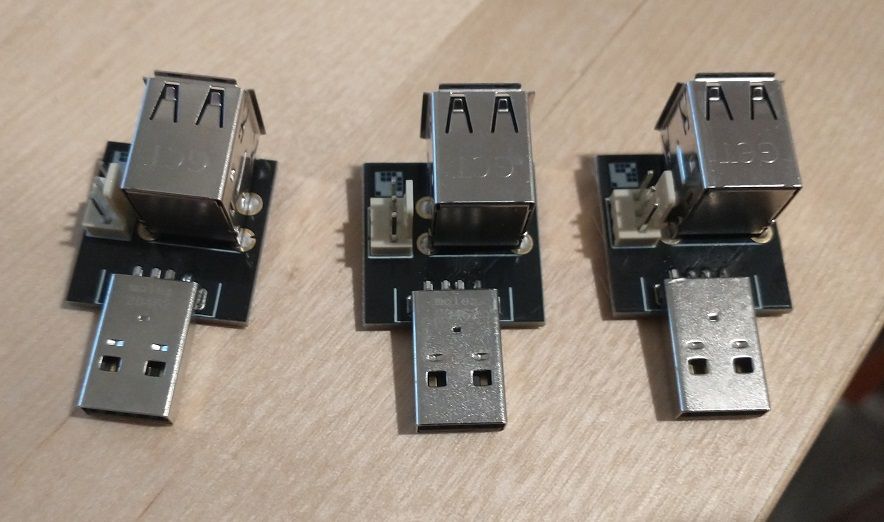  In case you're skeptical because all the good pictures here are CAD renders, here's the first one off the production line (I always keep the first one to play with; somewhere I have Compac serial number GS-10000000 and every museum is jealous) 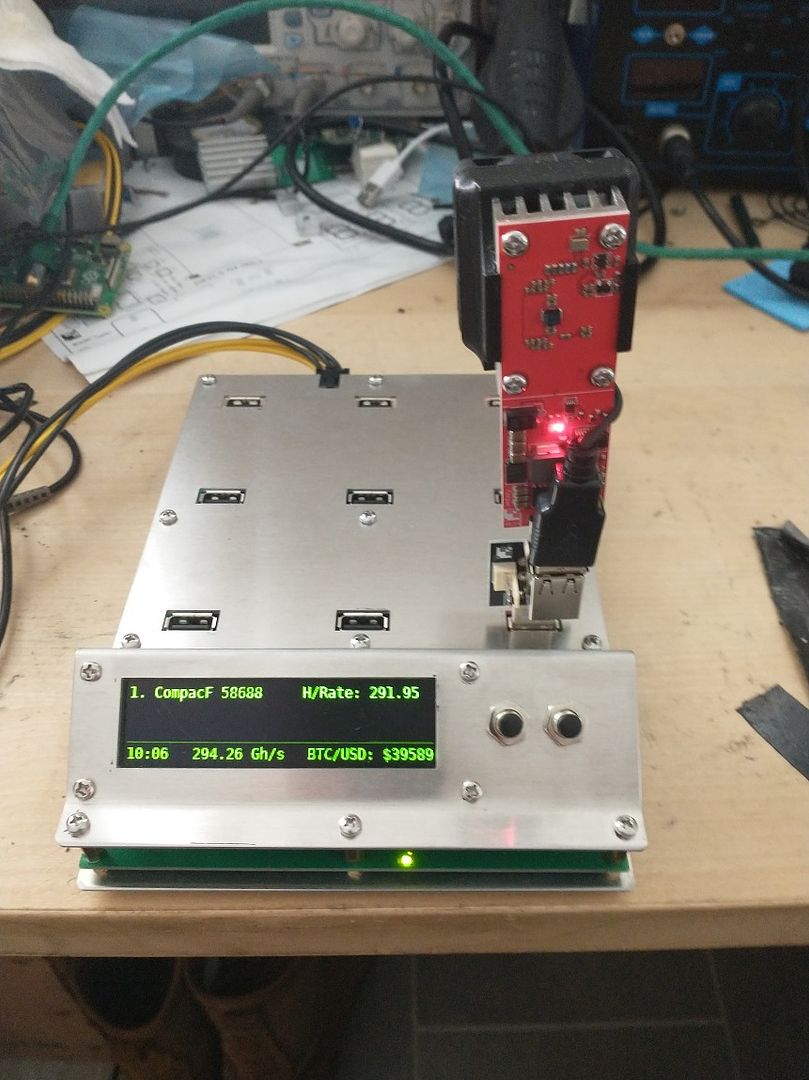 The first batch is already shipping to resellers, and they should be available in time to reach you by Christmas (depending on local conditions of course). These authorized sellers will have stock: AltairTech (US)Bitshopper (Germany/EU) 101 Crypto (AU/NZ)The Solo Mining Co (UK)The Smart Hub is the first step in what will be a fairly significant revolution for GekkoScience mining hardware. We've got big plans and are looking forward to what's coming next. |
|
|
|
Introducing the newest quiet consumer miner from GekkoScience, the newest addition to the Terminus pod-miner line, the R909. It may not look like much right away, but it's a significant improvement over the R606 in almost every way. This miner is built with the same physical dimensions as the R606 so anything built around them would still fit this unit. Airflow ducting is the same, same 80mm fan. However, you'll notice ports and jacks are located at the exhaust end instead of accessible from the side. This makes the unit more readily stackable, as you no longer have to keep three sides clear - two for airflow and one for cabling. It also allowed us to expand the circuit board by 15%, making room for a better main regulator and improved thermal management. Heatsink area over the chips is increased by 40% over the R606, and we've added more board mounting legs for improved stability especially during shipping. The miner runs on the S17's BM1397 ASIC, as used in our Compac-F USB stick miner. Kano has been hard at work improving the driver, and has added several features that will be very attractive to tuning enthusiasts, though the stock settings will already be fairly excellent. The miner is guaranteed to run at 1.5TH from under 100 DC watts at stock voltage and do it nearly silently. Better performance isn't guaranteed, but is probably attainable. Take for example the test unit I had running 1.8TH at 70 watts, or the above-photographed machine which pulled down almost 2.1TH from 88 watts (on stock voltage, no voltage tuning) for over a week: The Terminus R909 needs an external controller running cgminer, with USB connection to the miner (a 6-foot USB cable will be included with purchase). The driver has been tested extensively on linux PC and Raspberry Pi. Like previous Terminus models, the miner runs on 12V power from either a standard 2.1/5.5mm barrel jack (rated for 8A) or a PCIe 6-pin jack. The "stock" speed will be set to 400MHz, expected to see 1.6TH, but higher frequencies are possible. Kano will explain the details, but he's been working on adding tuning features which include setting individual chip frequencies. Core voltage is adjustable in the range of 1.4V-1.6V per chip, same as on the Compac F, and though the R606 had a fancy push-button interface, we've rolled back to a basic knob you turn with a screwdriver on this one. That may be improved on future versions but I won't make promises just in case. This miner also features Blinky Lights, but they're not as intrusive as previous models of pod or stick. The rate of blinking is proportional to hashrate. The base light color is a delightful pink-magenta. The BM1397 chips have a significant temperature coefficient, which means that they pull noticeably more power as they get warmer. Nobody at GekkoScience will be offended if a tuner or enthusiast upgrades the fan, as more airflow could mean reducing power consumption by 5-10% just from maintaining lower temperatures. These units take a standard 80mmx25mm 3/4-wire 12V case fan. And like all GekkoScience products, the Terminus R909 is Made In The USA. Approximate dimensions: 3.5 x 4.2 x 6 inches.
SALES So far, two resellers have confirmed to stock this machine, and should have stock in time to start delivering orders by Christmas. Production is already well underway on the first batch. This post will be updated as more sellers are added. bitcoinmerch.com shipping from California
419mining.com shipping from Ohio
bitshopper.de in Europe/Germany (forum user MacEntyre)The Terminus R909 will include a 6ft USB cable. It'll be up to resellers to provide any extras, power supplies or anything. |
|
|
|
EDIT: Kano's setup instructions can be found HERE: https://bitcointalk.org/index.php?topic=5355470.msg58200639#msg58200639
Hey guys. So some of you already noticed because of reseller presale announcements, but we're dropping a new stick built around the S17 BM1397 chip. We call it the Compac F. It is red. Hot-rod red. It is also made for overclocking. Hot-rod overclocking. The two photos above were taken from the same test. I haven't stressed my tester sticks past 3 Amps from the USB bus, but if you are able to keep everything cool, in theory, the hardware should be good for more like 500GH. Which is a little absurd. Kano is working on the driver for this guy, and we agreed to cap the speed to 800MHz (538GH theoretical) for safety and sanity's sake. Because of a new IC package design by Bitmain, the chips cool more efficiently, which when coupled with our proven robust Compac power systems makes this stick quite a machine. This isn't going to be marketed as a baseline miner like the Compac, 2Pac, NewPac. It's physically compatible with our previous USB sticks and built off the same proven platform, but this one is a limited release with only one planned batch. If enough people want it, we may make more. Resellers are all the usual suspects. 419Mining, ASICPuppy and BitcoinMerch are stocking in the US. Bitshopper.de is selling in Germany, and Eyeboot.com will have stock in Hong Kong. MineFarmBuy is also interested but are a broker, not a reseller, so you'll have to talk to them to figure it out.
|
|
|
|
|
I've got two A921 units with dead fans and I'd really like to use them as space heaters since I'm having to run electric heat in my shop anyway. Need two replacement fans if anyone's got 'em; I'd rather not have to wait for China to come back from vacation in a week and then get shipped overseas. I've got 120mm fans from just about every model of miner to ever use 'em, but nothing for the big 140mm these take.
|
|
|
|
|
...that ran around 2TH over USB from around 145W (12V PCIe), would anyone buy it?
|
|
|
|
|
Hello, guys. Got a quick question.
If I were to build a USB-C bus-powered miner would anyone buy it?
What I'm thinking is a small self-contained device, probably around 8cm cube, that takes in 12V/5A from a USB-C PD bus and therefore doesn't need a brick.
Problem is, I don't know how common it is to have a host capable of doing that. A brief glance seems to indicate most motherboards with USB-C just tie it to a 5V/3A dummy bus and have no support for PD protocol, so it looks like this device would not be compatible with the majority of available hosts.
I have no USB-C equipped devices. My newest computers came from scrapyards. I have no direct experience with that system. But the idea's been tossed around long enough, and goodness the USB-C PD standard has been out for years. Is it widely available enough to merit the effort of designing and building a product for it, or is everyone stuck on 5V/3A which is still stickminer territory?
|
|
|
|
Hey guys. I'm sidehack. Haven't ventured over here before; I have lived in the Hardware section for the last seven years or so. My small electronics company is probably known for being one of the first to make server supply breakout boards, and one of the last to still make non-industrial miners. All my products are designed and built in-house in USA, including parts population, metalwork and machining. I spent some time end of last year thinking about LED lighting and cooked up some custom fixtures for the new shop I spent last summer and fall building. That got me thinking about an old and largely unsatisfied desire for a durable non-stupid LED flashlight. Around 2012 or 2013 I spent a fair amount of time trying to find a single-cell 18650 flashlight, pocket-sized (which means no big goofy head), with about 200lm nominal output, simple modeless on/off, in a durable aluminum housing, with adjustable optics and no jagged edges. Found exactly one product that met all my specs so I bought two of them. One burned out and the other was stolen. I have found a few places somewhere in the world listing it for sale but I'm not convinced new ones have been manufactured since about 2013.  I had, before finding that one, settled on a different light that met most of my specs. Single-cell 18650, pocket-sized, about 200lm nominal output, simple modeless on/off, in a durable aluminum housing, but a fixed reflector and jagged edges on the head. Still, that's pretty good.  My biggest beefs with the mass of already-available "tactical" form-factor LED flashlights center around all the annoying strobe multi-modes and that they've always got those sharp-cornered protrusions around the lens which are just asking to scratch every available surface and wear holes in your pocket fabric. I really REALLY don't want either of these features and yet they appear to be essential. So fast-forward 8 years. None of the electronics still work entirely but I have the complete housings. I also have a lot more design experience and some electronics assembly equipment. Maybe instead of spending time trying to find a flashlight that someone else built which meets my apparently very unique requirements, I should build it myself. And then perfect it and make it available to anyone else who also wants one. Regarding housingsThe first (and better) housing, the C84, the "pill" is aluminum and threads into the main housing, meaning lots of solid contact for heat dispersal. The head is lensed and slides to adjust the beam width. It's pretty nice. Unfortunately I have yet to locate anything even comfortably equivalent on the market so acquiring something equivalent might have to be a custom job. The second light, the 501b, has a fixed orange-peel parabolic reflector for a fixed-spread beam. The "pill" is brass and mounts on beefy spring contacts which are great for grounding but not as great for shunting heat into the case. I already know I can get those housings and the mechanical innards in bulk from a Chinese manufacturer for not a bad price. They're kind of a "generic" design apparently because I've seen a lot of different brandings of the same thing. Chinese sourcing is less than ideal since I prefer to do as much American business as I can, but this project is just getting started. If possible I would like to request custom machining of the 501b lens end to make it a smooth ring and get rid of the half-dozen fingers. Something like that might be negotiated for batch orders of sufficient size. I already know they'll do custom logos. Regarding electroncsThe standard driver board for LED flashlights is a 17mm circle that fits inside a milled billet, aluminum for the C84 and brass in the 501b. Bottom side of the board will have a spring contact for the hot terminal of the battery; bare contacts or castellated holes around the circumference conduct ground to the billet, which grounds through the button to the battery's negative terminal. The LED is mounted on a separate board adhered to the other side of the billet, which serves as a heatsink. Wires run from the LED disc through a hole drilled in the billet and are soldered onto contacts on the driver board. I currently have two LED options to play with: CREE XM-L2 U2 5mm lensed LEDs which can handle a practical maximum of 3A and put out in the neighborhood of 400lm per amp (300lm/700mA, 500lm/1250mA, 840lm/2500mA) and some baby CREE JB3030 3mm unlensed with a practical max of 240mA and peak around 120lm. I have a functional prototype DC buck driver which can work from the 3-4.2V output of a single lithium-ion 18650 cell. The driver will be built to handle 2.5A through the LED, and internally uses a PFET for the high-side switch which means 100% duty cycle low-dropout mode when the battery is at the bottom end of discharge - that is, the light will get dimmer rather than turning off when the battery starts to die. The driver is designed with a microcontroller to continuously monitor LED current draw and adjust the buck driver's output voltage to reach and maintain target current (which means target brightness) as conditions like battery voltage and LED temperature change. The software is coded to do a soft-start rampup which brings the light from "off" to full brightness in no more than about 50 milliseconds. What this means is the brightness can be set in software, by giving the calibration routine a particular current setpoint to target for. The flashlight, then, can be configured for different brightness from around 50lm (brightness can be unstable/jittery at low currents due to circuit optimization for high currents) to 800lm without modifying hardware. The microcontroller is wired such that it can monitor battery voltage and turn the light off completely if the battery reaches a certain state of depletion, preventing harmful deep discharges. I have not done this; just noting that it's possible. Regarding modesNow I've stated pretty clearly that I hate multi-mode. I don't want all the BS of accidentally cycling into some dumbass strobe when I'm trying to look at something. Just want on and off. However, multi-mode wouldn't be found in almost literally 100% of existing products if it wasn't, for some reason, a popular feature. The driver I'm building is designed, therefore, to allow multi-mode capability in software. Mode switching happens by pressing the power button quickly. What this does is actually power-cycle the LED driver circuit. There is no extra contact for half-presses or anything, it's just a quick power-cycle because the switch doesn't latch off. The driver circuit is designed to notice a short-duration cycle and, upon returning to power, advance to the next mode. My driver will be capable of doing this, and I'll probably write a basic program to implement cycling through brightness modes (2-mode low/high) and one with a strobe routine to test out setting up timers and the best means of rapidly cycling the LED. I will probably put the mode-switch timeout as pretty low, down around 500 milliseconds. This should reduce the chances of accidentally jumping into another mode by turning the flashlight fully off and then turning it back on very quickly. There will be no long-term memory; once the timeout has expired, it'll default to initial mode. And since it's a software thing, this timeout will be adjustable. Regarding softwareYou'll notice a common theme here: the hardware is built to be robust, with a lot of the flexibility and feature set implemented in software. This is deliberate. It would allow me to easily customize batches of flashlights for particular orders, and allow me to "stock" generic option sets as different sub-models by simply flashing the driver board with the right hex file before testing and packing. But it also, quite deliberately, puts a lot of power in the hands of the end user. Makes the product quite hackable without having to do any "pencil-modding" or desoldering. In fact, I'm even putting test points on the underside of the driver board which can be wired to a PICKit for updating the firmware in-system. I have only implemented software on a test board using a similar microcontroller so I can't guarantee anything at this time, but the driver board is currently designed to use a PIC12F1571 microcontroller. Current is monitored using an ADC measuring the output of a low-side current sense amplifier and adjusted by changing a PWM output's duty cycle. Right now current is measured and calibrated every 2 milliseconds. OptionsA bit of discussion on this subject happened in another thread elsewhere, so since it was way off topic we all decided it'd be better to start a specific thread just for flashlight development discussion. Over there the idea came up to make one specifically with a low brightness for use indoors at night. With that in mind, I figured out a fairly simple way to modify my driver board, by replacing only 2 or 3 parts, to operate at 0-250mA instead of 0-2500mA, adjust the current sense amplifier's gain, and operate using the smaller LED for a peak-120lm flashlight without any changes to software. So probably what I'd do is stock both versions of the driver board, and LED discs for both diodes, and then both the 501b and eventually C84-equivalent housing. With a few different stock softwares to flash, I can offer a large variety of stock "models". 501b housing, XML2: ZeroBS High (300lm, on/off) SomeBS High (150lm, 300lm, 2-mode) AllBS High (150lm, 300lm, strobe, 3-mode) 501b housing, JB3030: ZeroBS Low (50lm, on/off) SomeBS Low (50lm, 100lm, 2-mode) AllBS Low (50lm, 100lm, strobe, 3-mode) C84 housing, XML2: ZeroBS Zoom High (300lm, on/off) SomeBS Zoom High (150lm, 300lm, 2-mode) AllBS Zoom High (150lm, 300lm, strobe 3-mode) C84 housing, JB3030: ZeroBS Zoom Low (50lm, on/off) SomeBS Zoom Low (50lm, 100lm, 2-mode) AllBS Zoom Low (50lm, 100lm, strobe, 3-mode) The names indicate the level of BS you'll have to put up with in stock configuration. I'll always prefer the ZeroBS, though SomeBS high/low modeswitching is not unattractive. Might consider, if demand is high enough, doing a MaxBS version comparable to readily available 5-mode lights, which implement three brightness modes, strobe and SOS. ChargingIt's also been mentioned that I should build a battery charger. That'll be something to look into for sure, but I make no guarantees. Very likely what I would do is a USB-powered charger. A lot of USB ports now are good for 2A output, and everyone and their mothers have those little plug-in USB power adapters that probably also run 2A. I build a pretty solid USB hub that can put up 3A per port without trouble. 1A is a good charge rate for a single 18650 cell, which means a 2A-capable USB port could source a 2-cell charger. The charge curve for a lithium cell is pretty easy; constant current until peak voltage (4.2V) is reached, and then constant voltage until current flow is 3% of initial charge rate, then stop. No floating charge required, since that can actually damage the cells. Overvoltage can't be tolerated, so that 4.2V peak has to be measured within 1%, ideally even tighter. And add in a temperature sensor to make sure the cell doesn't overheat, which can indicate damage. The same kind of current-measurement and dynamic voltage adjustment system used in the flashlight driver could also be used in the battery charger. Start low and ramp up the voltage to reach 1A continuous, then maintain 1A continuous until it reaches 4.2V, at which point the calibration switches to keying off voltage with current monitoring continuing in the background. Turn off the power entirely once current drops to 30mA. Poll a temp sensor on the I2C bus frequently to check for overheat conditions and lock it down when safety thresholds are hit. The electronics and the program aren't really a problem. The fun will be designing the housing to put it in and making sure it's something I have the tools to efficiently manufacture in bulk. end of presentationSo, that's most of what I've got and a couple tidbits of other people's input already bundled up and considered. Anyone else got any input? |
|
|
|
Introducing the newest quiet consumer miner from GekkoScience, the newest addition to the Terminus pod-miner line, the R606.Finally, that quiet efficient stackable adjustable 60-120W miner we've been looking for since 2014! This miner, built as an expansion of NewPac tech, is a significant improvement over the previous Terminus R808 with BM1384 ASICs. The R606 is fully-enclosed in an aluminum shell for better air ducting (including better main regulator cooling for high-end stability). Heatsinking is improved for more efficient ASIC cooling, plus the integrated 80mm quiet fan is a standard size easy to replace or upgrade. The miner features 12 of Bitmain's BM1387 ASICs (as found in the S9) and an adjustable core voltage (from 390mV to 460mV) using a simple push-button interface to step up or down in 10mV increments with internal calibration and a fairly straightforward LED readout. No screwdrivers or meters necessary! The Terminus needs an external controller running cgminer, with USB connection to the miner. Every Terminus miner has an internally regulated 5V USB power output (2.5A limit) which can be used to power a small controller like a Raspberry Pi. The miner runs on 12V power from either a standard 2.1/5.5mm barrel jack (rated for 8A) or a PCIe 6-pin jack (rated for more than you'll ever need). Driver support in cgminer is still in development but VH has made a lot of fantastic progress. We have automatic detection of unresponsive ASICs forcing a string reset, which will prevent damage to underperforming chips and recover from "zombie" conditions. ASICBoost is supported and is now enabled by default (with pool support detection), with a user flag to disable it if necessary. BM1387's implementation of ASICBoost not only improves efficiency by roughly 20% but reduces USB traffic by roughly 70% so it's basically essential for hitting the high hashrates.  The "stock" speed is about 750GH with an estimated 8A-draw hashrate around 950GH with ASICBoost enabled. Early device testing has seen Terminus R606 hit speeds in excess of 1.1TH; however, since we do not bin ASICs and the stability of the entire string is dependent on its weakest chip, maximum speeds are not guaranteed. We're still working on acquiring thorough performance statistics using VH's new auto-tune routine, designed to find the peak stable speed of each device, which is another very exciting driver development. Since I know what you guys love, this miner features BLINKY LIGHTS! The rate of blinking is based on the hashrate, scaled against the voltage setting, to approximate stock NewPac timings. The base light color is orange. And like all GekkoScience products, the Terminus R606 is Made In The USA. Approximate dimensions: 3.5 x 4.5 x 6 inches.
SALES So far, at least three resellers are confirmed to stock this machine. MinerSupply on Amazon.com (forum user Rockmoney)MineFarmBuy.com (forum user minefarmbuy) 419Mining.com (forum user 419mining) Limited direct sales are also available; contact kalahn@gekkoscience.com for information. The first batch is limited to North America only, in case of unforseen warranty, reliability or support issues. Global sales should be available with the second batch. The Terminus R606 will include a 6ft USB cable. Kit packages will also include a high-quality 8A DC power brick. Resellers may also put together other package-deal offerings, so shop around a bit. Most resellers should have listings go live within the next 24 hours. Given that this miner is roughly equivalent to six NewPacs with a hub and fan, Retail Pricing is around $300 for miner, $325 for miner with 8A brick.The first batch is still in production, though we're mostly only waiting on accessories like power bricks and fan grilles, and should be shipping before the end of April. Production and shipping should be fairly continuous after that point.
|
|
|
|
I know what you're thinking. This post is going up April 1 and you can't trust anything you see on April 1 Well you're wrong. 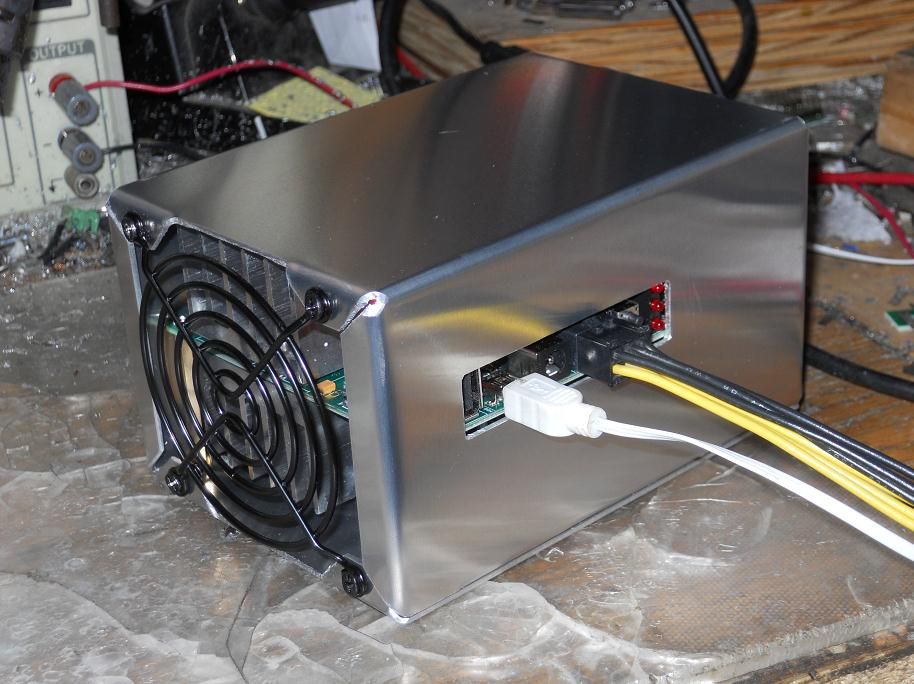 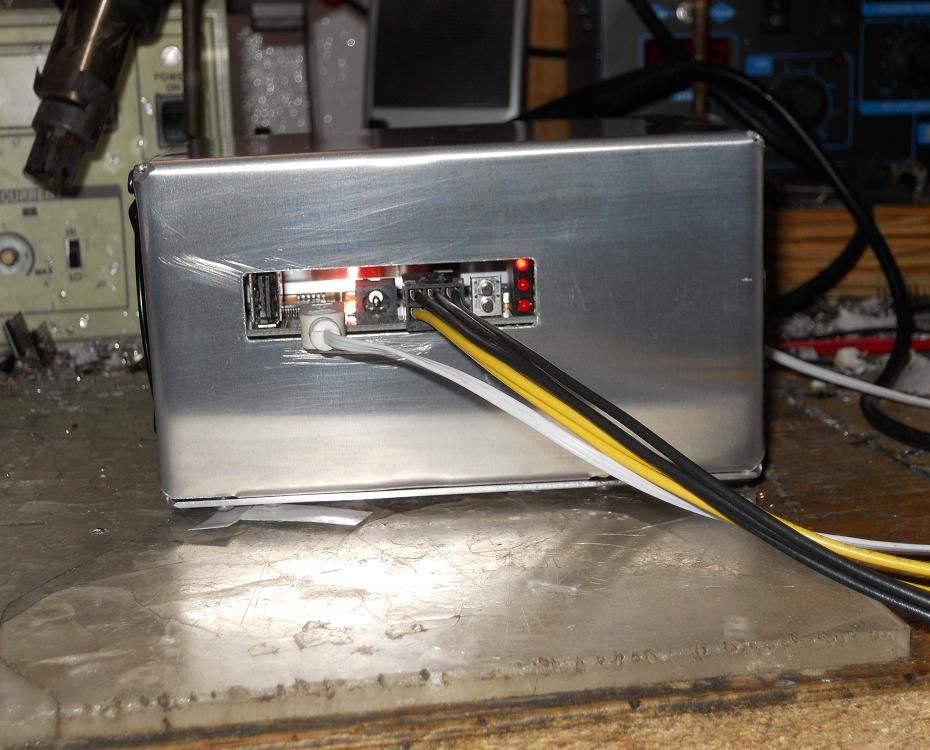  (homemade samples of case branding/labeling) I still need to do some fine-tuning on the housing, and slap a big fat logo on it, but this here is a fully functional prototype of the all-new Terminus R606, building on the work of both the R808 and NewPac USB and progressing in secret since January. The theoretical peak hashrate of this guy is upwards of 1100GH but that's not guaranteed, and may require a fan upgrade. This fellow is designed for cool, quiet and convenient. Worry not that it's a wimp, though, because the stock settings should get you upwards of 600GH (close to 700GH with ASICBoost enabled) from a 12V 5A power brick. My tester is pulling 820GH from 12V/6.1A right now with a heatsink temperature of 50C and I almost can't hear it running. R808 users will notice a few obvious improvements over the original. First and foremost, it's completely enclosed. Makes it quite a bit safer and easier to handle, for sure. Second, dual heatsinks. Cooling is much more effective. Third, standard 80mm quiet case fan is easy to upgrade without having to track down exotic hardware, and it also cools the Vcore regulator for improved overclock stability. The familar jacks are still present - USBA 5V output for powering a small controller, plus 12V in from a barrel (8A rated, upgraded from the 5A jack on the R808) and 6-pin PCIe. Next we've got a nifty new feature, push-button voltage control. Instead of having to turn a knob and guess at your settings or dig for a meter, now you can adjust from 390mV/chip to 460mV/chip in 10mV increments with the push of a button, and your current setting is counted off on the 3-bit binary LEDs. (yes there'll be a user guide with further details on this feature) This is not a for-sale announcement, but we're prepping to start manufacture literally right now and they should be shipping soon. I don't have any in-house sales rep this time around, so talk to your favorite reseller and let 'em know you're interested. |
|
|
|
 So, I've been working in secret the last few months on a new stickminer to replace the venerable old 2Pac. It's not as good as I would like - certainly less fancy, but we have to remember that the GekkoScience design philosophy is "Simple, Durable, Reliable".  This new stick, the NewPac (so named because it's quite obviously just a newer version of the 2Pac, which was itself just a two-chip Compac) features a pair of Bitmain BM1387 chips and a stock clock setting of 100MHz for 23GH. The chips are pretty bad at thermal runaway which means 100-125MHz is a practical top-end for passive cooling, though with moderate airflow they'll run 200MHz (45GH) at under 5W on stock voltage. I have seen these sticks pushed to 90GH, which makes them roughly hashrate-equivalent to my Terminus R808 pod miner but from about one fifth the power draw. It's theoretically possible to overclock to 130GH but this will require a strong hub and possibly custom cooling. I have not tested past 90GH. Every stick is tested at 45GH before shipping. VH's new Gekko cgminer driver is able to detect and recover from the same kind of issues which would have caused a "ZOMBIE" condition on the 2Pac, meaning increased reliability and less attention to maintain long-term operation. The stick is dimensionally identical to the 2Pac, so any custom hardware designed for one will work for the other. And of course it's got BLINKY LIGHTS! For the time being, I have no plans to run direct sales. I have more projects on my plate for the next six months than I have time for (including bigger and better non-industrial miners), so we'll be operating entirely with resellers - specifically CrazyGuy ( https://asicpuppy.com/magentoPuppy/) and 419 Mining ( https://www.419mining.com/) to start.  |
|
|
|
|
Admittedly I don't get around much. I'm a hardware guy, have always been a hardware guy, got started with bitcoin mining and this forum in 2013 because the hardware was interesting. So I spend most of my time between Hardware and Mining Speculation.
I've noticed lately there's been a lot of "cleanup" on the Hardware forum. Some things are handy, like tidying of massive inline images or dozen-deep nested quotes. That's quite useful.
But then there's a whole lot of removing posts or entire threads going on, much more than I'd seen in the previous five years. Someone mentions a new piece of gear, folks wonder about it, and the next day all traces of discussion are gone. Or within a thread, many posts following the flow of conversation still peripherally related to the subject, or any post even mentioning the existence of altcoins, disappears. Many can attest to removal of posts calling particular un-verified manufacturers into question during discussion of new hardware, but that I believe was mostly in Speculation (though the moderator may have been the same).
I've witnessed several times someone new will ask a hardware question, and a knowledgeable member will provide an answer, and within hours both question and answer will have been deleted without good reason. This discourages active participation and reduces the forum's reputation as a resource for information.
The recent most obvious instance of thread deletion is discussion regarding Bitmain's new water-cooled S9. In the last six days I have seen four threads discussing this machine started and promptly removed. Apparently whoever's in charge there insists that all discussion of the water-cooled S9 be limited to the main S9 thread, already heavy laden with over two years of clutter. This ignores the fact that the watercooled S9 is a completely different machine than a stock S9 - in addition to waterblocks, the physical hashboards appear different and there's more of them. These differences, and a plethora of other facts unique to that machine, were being actively discussed in every deleted thread. The T9 is closer kin to a stock S9 than the watercooled unit, and it gets its own thread, apparently simply by merit of having a different name.
Why is this overmoderation, bordering on censorship, acceptable and allowed to continue?
|
|
|
|
|
Like the subject states, I am looking for S5 and S5+ miners. Dead hashboards accepted as well, subject to negotiation depending on condition.
I can pay outright, or trade for other gear. As a reference, right now I'll trade 4x 2Pac USB stick miners for one S5 hashboard.
PM me if you have something.
|
|
|
|
Newest update - https://bitcointalk.org/index.php?topic=2474532.msg42630173#msg42630173I have 2Pac factory seconds available again, at $16. Laura's also back in treatment so she'll be getting $10 of every sale and the rest is basically the value of usable parts were I to strip them and recycle the rest. Not even looking to recover cost on these, just utility and donation.
So probably a lot of you are familiar by now with my 2Pac USB stick miner. I closed general sales in June because I was finding it increasingly difficult to keep up with both communication and manufacture. Bulk sales are still accepted and resellers are taking a whole lot of the load off my back. Between that and improved infrastructure, the weekly output of 2Pacs from my "factory" has more than doubled. For anyone wondering, non-bulk "individual" sales accounted for roughly 15% of early-batch sales, while communication for individual sales (plus aborted order requests) accounted for roughly 95% of communication. So by offloading those sales to resellers, my overall sales volume was basically unchanged but I was able to reduce my "wading through emails" time down to a fraction of the total. So some of you guys also noticed that in the past I've sold "factory seconds" 2Pacs. A stock stick has to pass bench testing before final assembly and then a two-step test at no higher than 1.26V before shipping; a "seconds" stick will have failed testing (due to HW errors and/or instability) at stock voltage but will have passed at no higher than 1.40V on the dial. This reduces the baseline efficiency and overclockability but, as far as I can tell, they're still fully functional. I started selling them in part because I had a lot stacking up - earlier batches of chips weren't as good as what I'm using now so I had up to 10% failures, most of which became seconds. The numbers are better now, but they still stack up, and I like at least getting some of the parts cost back. The other and more significant reason is, all profits from the sale of 2Pac seconds goes to a particular GoFundMe account. The beneficiary (Laura) is a friend I've known for going on 12 years who's been going through some rough times and is in treatment for an eating disorder. Which ain't cheap, even with insurance. Inpatient treatment kinda keeps you from having a job, and her folks are both teachers (don't even get me started on how undervalued educators are these days) so the whole family could use some help. So, I'm going to use this thread as a central gathering place for all the as-of-yet scattered and varied information about 2Pac Seconds sales. I sell them for more than, but not less than, $32 $16 apiece plus shipping. I say "more than" because anything extra you pay will go straight to the fund. Any $32 $16 sale automatically puts $10 in donation, but you're more than welcome to add more to it if you want. In order to help her out even more, Laura will be taking on the job of "sales rep" and handling customer communication for small orders. We're going to start off with 2Pac Seconds as something simple to iron out the kinks. So instead of contacting me for purchasing, you'll contact her. Which is probably good because she's a lot nicer than I am. I take PayPal and BTC. Shipping is $10 for any order within the US. Know before you buy that you are buying something DISCOUNTED and NOT AS GOOD AS STOCK and with LIMITED SUPPORT. Supply is limited. To place an order: Email to sales at GekkoScience.com: 0) that you specifically want 2Pac Seconds 1) desired quantity 2) expected payment amount (don't forget to add shipping) 3) preferred payment method (BTC or PayPal) 4) shipping address Also, I have Rohs-compliant sticks but they're all bitshopper-branded and marked with his WEEE registration so I can't really sell them to other people. Bitshopper's okay with them being put in general circulation as seconds outside Europe but not within Europe because he could get in trouble with WEEE reporting. Which means I can't sell seconds sticks in Europe without breaking some rule or other.
2Pac Seconds sales to date have donated: well over $6215 |
|
|
|
Oh, hey guys. So a couple of things going on here. One, I've been working on a pod miner for a while. Final-version prototype PCBs are on order, but I've got some of a previous version functional. Four, to be specific. These guys are packing eight BM1384 miners and operate off the same driver as the 2Pac 2-chip stickminer. The voltage is fixed but they're tested to 250MHz (110GH) and should be able to do that handily off a 12V 5A brick (not included, I don't really have any extras). Aside from a very few mediocre models sent out to resellers and VH who wrote the driver, these would be the first fully functional GekkoScience Terminus pod miners in the wild. So, here's the scoop. I've got a friend, a girl I've known and respected for eleven years and a piece, currently in treatment for an eating disorder. Her dad set up a GoFundMe page at https://www.gofundme.com/lauras-eating-disorder-recovery and all the proceeds from the auction of these miners will go to that end. Anyone just feeling altruistic can donate directly, I guess. I will cover shipping for any winning bidders within the US. Outside the US, we'll work something out. Here's how this will work - there are four miners, so the top four bids will get one miner each. I'll let it run a full seven days, so bidding ends 7PM US Central time on Monday, July 3rd. Bidding starts at 0.03BTC  |
|
|
|
|
I am in need of S5 miners for chip harvesting. I will trade one GekkoScience 2Pac USB stick (up to 35GH with a stout enough hub) for an S5 hashboard in fair condition. Entire miners (fans, heatsinks, what have you) I'd take for cash or trade which includes credit on a forthcoming 8xBM1384 pod miner good for about 100GH/35W up to 140GH/60W.
If you're looking to clean your closet, let me know. I require many.
|
|
|
|
 http://solo.ckpool.org/workers/1BURGERAXHH6Yi6LRybRJK7ybEm5m5HwTr_TERMINUS http://solo.ckpool.org/workers/1BURGERAXHH6Yi6LRybRJK7ybEm5m5HwTr_TERMINUSWhoops I must have forgot to mention I have a new pod miner in development, the Terminus R808. It still uses BM1384 (8 of 'em, hence the name) that should run 100GH off a 12V3A brick and 140GH from a 5A brick. Haven't fully tested yet but it should run that 100GH without a fan (turn it on its side for improved convection), and it has adjustable core voltage and built-in 80C thermal shutoff. At four inches square, it's the smallest not-stick Bitcoin miner made in what, two years? Everything works except the main Vcore power is misbehaving so I'm redoing that part from scratch. The new layout is already done and I'll be sending off for prototype PCBs tomorrow. It also already works with VH's current cgminer build. My test unit (running off a hacked external buck) is hashing away at 250MHz (110GH) as seen in the link above. |
|
|
|
GENERAL SALES ARE CLOSED - If you only want a few, talk to a reseller because if you email me I probably won't even respond.
To anyone who buys from a reseller, that person is your first point of contact for any support issues because that person got your money, not me, and the markup you paid means the seller owes you good customer service. So don't ask me for support requests unless you bought from me directly. Or check here - 2Pac Support Thread
GekkoScience is currently working on a variety of miner projects. The biggest news is, I have access to Bitfury's new 16nm mining ASIC and will be designing a family of miners around it. I say "family" because I'm looking at a 2-chip USB stick, an 11-chip "pod" (40-100W standalone) and a 33-chip board (~220W, adjustable up or down) designed to fit on S1/3/5 heatsinks. In order to help raise money for development on these projects, I'm working on some simpler products that follow along after the BM1384 Compac project from last year. Because BM1384 can undervolt down to about S7 stock power (0.25J/GH chip-level) and they're easy to work with, these "fundraiser" projects will keep using them. The plan is to build a 2-chip USB stick and an 8-chip "pod". The pod miner I expect to have a 35W hashrate about 88GH, with a peak 70W hashrate of 120GH. When I have them prototyped and ready I'll have more info for you. The USB stick, let's call it the 2Pac, will have about the same baseline hashrate and efficiency as the original Compac but per-hashrate efficiency increases quite a bit as you crank it up, and cooling should be more effective. That is to say, if all you want is a 2.5W stickminer it's no better than the original, but it's quite a bit more overclockable.  | Freq | GH | Vcore | Power | J/GH | | 100 | 11.00 | 1.26 | 3.67 | 0.33 | | 125 | 13.75 | 1.26 | 4.48 | 0.33 | | 150 | 16.50 | 1.26 | 5.27 | 0.32 | | 175 | 19.25 | 1.26 | 6.12 | 0.32 | | 200 | 22.00 | 1.32 | 7.43 | 0.34 | | 225 | 24.75 | 1.36 | 8.73 | 0.35 | | 250 | 27.50 | 1.40 | 10.11 | 0.37 | | 275 | 30.25 | 1.46 | 12.25 | 0.40 | | 300 | 33.00 | 1.50 | 13.98 | 0.42 |
A driver with baseline functionality has already been developed, and by deployment should be both backward-compatible with the original Compac and forward-compatible with the pod. Since this is a fundraiser for better things, I'm actually putting up 3 different ways for people to pitch in. 1BURGERAXHH6Yi6LRybRJK7ybEm5m5HwTrThis is the general donation address for GekkoScience projects. Bitcoins put in here will go to prototypes, parts and the occasional hot sandwich. 12PACBUYyFhRyhRB4qB9Z5Z8M6E3p8gpmtThis is the general sales address for the 2Pac. It'll be used to buy materials to manufacture the 2Pacs, and the surplus will be funneled straight into BF16 project development. I also accept PayPal payments at sales@gekkoscience.com12pAcLoAN9yhTbSbPwCiJFeDkw8zMAxYyHThis is a new thing I'm trying out. This is a 2Pac Loan address, and and coins here will be used for 2Pac manufacture, the profits therefrom going into BF16 development. Once the BF16 projects are rolling and turning a profit, all the coins paid into this address will be paid back to the sender's address. MacEntyre has stock for EU sales through his website bitshopper.de valkir is arranging a Canada group buy in an adjacent thread. Eyeboot.com will be stocking for the Asian market, and also sells some beefy USB hubs. 2Pac sticks are $30 apiece for any quantity. For the sake of simplicity, I'll charge a flat $10 on shipping for all US orders. If you're interested in purchasing, PM me here or email sales@gekkoscience.com with quantity, shipping address and desired payment method.
|
|
|
|
|
I'll update with proper specs and conditions, but for now let's start with a list. Gonna do some housecleaning. I'm pretty sure the two rack SP units are one 30 and one 31 but I'll verify that before promising anything.
I have for sale:
1x Avalon6 with RPi controller
1x Antminer S4
1x Spondoolies SP30
1x Spondoolies SP31
6x Spondoolies SP20
1x Bitmain APW3 PSU
100x Dell 750W server PSU (no boards or cables, just the supplies)
4x Dell 750W server PSU with 4x 18" PCIe (hard-soldered) and on/off jumper
4x DPS1200 PSU
3x DPS800 PSU
5x DPS812 breakout boards for above PSUs (12x PCIe jacks)
30x Riser Power boards with cables (provides 5V/12V Molex power for GPU risers from 12V PCIe)
11x 120mm PFC1212DE fans (PWM lime snipped; Prisma pulls)
12x 140mm 0.45A fan (look new, intended for AMV2 blade rigs)
12x Antminer S5 I/O board
5x Antminer S5 Beaglebone
12x Dell monitor-mount speaker bars of various styles
30x Avalon A3218 ASICs (pulls)
30x Bitmain BM1385 ASICs (pulls)
100x 0.47uH >30A inductors (pulls)
Got projects to fund and some of this stuff is just taking up space. Make offers.
|
|
|
|
So I have a crew working on development for 16nm miners intended specifically for consumers. This includes a single-chip stickminer, a 10-chip pod miner and ~400W S1-chassis-compatible boards. But dev costs money and to help raise money I'm auctioning off some of the test setup stuff from previous miner design work. This includes three prototypes of a BW LK1402 Compac for which drivers are currently being written. The chip manufacturer has opted not to sell ASICs so no more will be made, but the software was already well under way when this was found out. The original plan was to pay the coder a percentage of sales, but if there's no production there can't be sales. The proceeds from the auction of the three LK1402 Compac prototypes will help make up for that; he plans to finish out the driver which means these sticks should be functional miners. Here's a list of what I've got up for grabs, in what quantities.  A3218 Compac - Unpopulated PCB x 12 A3218 Compac - Unpopulated PCB x 12 These are some test PCBs for Compac stickminers designed around Avalon's A3218 ASIC. Unfortunately there wasn't enough available information to really get things to communicate properly. One complete prototype was assembled and sent to the programmer but it never went anywhere. BM1385 Compac, fully assembled x 1 This Compac is built around a Bitmain BM1385 ASIC harvested from an S7 miner. I could never get the chip to talk, and since it's a 0.35mm pitch QFN and the chips suck to harvest anyway I wasn't too upset about it. I only built the one. It did successfully test a new power layout, so that's handy. BM1385 Compac - Unpopulated PCB x 4 The above-described miner, just bare PCBs. Populated V1.1 Amita x 4 The "Amita" is the pod-miner product line I want to actually exist someday. I did go through multiple BM1384 prototypes with varying levels of success, but since the BM1384 is painfully outdated I gave up on it. The platform mostly became a testbench for power, stability and manufacturing precision. These boards are built around 8x BM1384 ASICs in a bucked string topology and are, for the most part, populated with all node-level components and a functional power circuit. They probably don't work for one reason or another. Some were rewired to scab onto an S5 controller. Unpopulated V1.1 Amita x 3 The Amita is intended to have a USB connection and built-in microcontroller for fan speed and voltage adjustment. However, we didn't get around to writing the code for that part. All the footprints are there on this initial version, except I screwed up one of the jacks. Unpopulated V1.3 Amita x 8 The original (V1.1) test pod was designed for USB but that part was never implemented. On this second version I was more focused on just having a closed solution that worked, so I redid the power layout and removed all microcontroller stuff in exchange for an 18-pin jack, simulating an 8-chip S5 board the S5 controller would work with transparently. Ideally it would have been mass-producible but I still had some problems with stable voltage levels at the ASICs. Couple that with the BM1384 being a year old at that point and it wasn't really feasible. Assembled V1.1 Amita x 1 (starting bid 0.1BTC) This is an initial-test-version Amita which has been fully assembled with a proper cooler. I completed two of these but am keeping the first for my own archive. This one was wired up a little more stably to function off an S5 controller. The original concept was to make it compatible with Intel LGA1155 CPU coolers and with Freezer7 coolers that a lot of people might have dozens of laying around after the Technobit HEX4M debacle. This board is assembled with one of those. Assembled V1.3 Amita x 1 (starting bid 0.1BTC) I'll be giving up on CPU cooler compatibility on future Amita projects because it wastes a lot of board space trying to fit arbitrary standards, but the BM1384 Amita in both prototyped versions still used that concept. The ASICs are compressed into a 3x3cm square to fit under a Freezer7 cooler base or inside the center billot of a standard Intel cooler. This V1.3 Amita is fully assembled (including 18-pin jack and S5-compatible temperature sensor) but I don't recall offhand how functional it actually was. Hacked S5 8-chip test board x 1 This was my original bucked string topology test. It was a concept Novak and I came up with right around the same time ASICMiner (remember those guys?) announced the BE300 test specs, which was really what got us interested in miner design. We spent a full two days discussing the features and attributes we'd like to see in a miner. We wanted to combine voltage adjustability with the reduced parts count of string topology, so the obvious result is a high-voltage buck converter on a short string (like the S7 and S9 now use in a fixed-voltage form). My initial test of this used a hacked TPS53355 circuit rewired for variable 2.4-3.2V (instead of fixed 0.8V) powering a rewired section from an S5 board, which worked pretty well once some power kinks were ironed out. This became the basis for the Amita prototype boards.  Unpopulated 18-chip string test board x 2 Unpopulated 18-chip string test board x 2 The eventual goal of my miner design projects is to bring to market an S1-chassis-compatible board kit using modern chips. Thanks to Bitmain's early (and subsequently abandoned) leveraging of interchangeable parts, a board that'll fit on an S1 will also work on an S3 and an S5. These chassis have been tested to dissipate upwards of 500W without a lot of the reliability concerns which have plagued their later high-density designs, and they can be found for pretty cheap on the secondhand market. Our initial idea was to make each S1 a four-board kit (two boards per heatsink) where each board could operate as a ~100W standalone, not unlike what RockMiners did with several miner chassis designs based around the same PCB. This concept survives in a few half-S1 prototype PCBs designed for external power, basic UART signaling (intended for an external USB adapter) and 18 chips in a 3p6s string configuration. Lemon BM1384 Compac x 12 (minimum bid 0.16BTC) I'd like to sell these as a single unit if possible. I've gone through something like three thousand of these stickminers from start to finish - all our manufacturing is done in-house - and I've had a few that I just got tired of fiddling with. Some might have PCB issues, some might just be boneheaded oversights on my part, but most are pretty much fully populated (though none have heatsinks, since those aren't installed until they pass initial testing). I don't know how many someone industrious could get working again. Amita V1.1 stencil This is a 30x40 stainles steel stencil for the Amita V1.1 stencil. Darn thing had enough pads (several hundred) that it was well worth buying a proper stencil instead of trying to grease by hand. Most of the parts were in the same place on the V1.3 so it was reusable. BM1385 Compac stencil This is also a 30x40 stainless steel stencil, for the BM1385 Compac prototype. I ended up reusing the power layout on a couple future versions so this one was reusable as well. The Compac has few enough parts that I didn't really need it that much though.  BW LK-1402 Compac Prototype x 3 BW LK-1402 Compac Prototype x 3 (minimum bid 0.08BTC) The software is still in the works on this - an initial cgminer version already exists, but we're having trouble getting the initial prototype to hash on all cores. Even with all the overhead, right now it's still more than twice the hashrate of a BlockErupter at less than half the power. When it's working properly it should top out around 50GH at maximum overclock. Hopefully we can make that happen. BW LK-1402 Compac unpopulated PCB I only had 4 sample ASICs and will keep the first prototype for my archives, which means at most three more functional sticks will be made unless BW decides to open up sales. That leaves me with a single unpopulated PCB someone can have. Of course I always have regular power supply gear and custom cabling and other things available for sale over here ( https://bitcointalk.org/index.php?topic=940317.0) and I really like selling that stuff because it's my actual income. But if this auction is a success it'll greatly help to fund dev efforts on future miner projects. Especially the BW sticks, which will pay the programmer for the work he did on 'em. I've put minimum bids on things I'd like to get at least that much for, probably because of the materials and stuff in 'em. Shipping will have to be arranged between me and the buyer, shipped from MO, US 65401. Sales must be paid for within 24 hours of the auction ending, paid to address 1GekkosciLeaey8Na9siC8oD5HcMtLnWwdThe action will end Monday 10/24 at 5PM CST. Any bids submitted after that time won't count. Standard rules apply - quantity @ price in a post on this thread counts as a submission. If the highest bidder doesn't take 'em all the next-highest bidder can match price. Any items not paid for within 24 hours of the auction will be offered to the next highest bidder. Alright guys, be civil. |
|
|
|
|

















